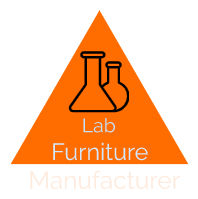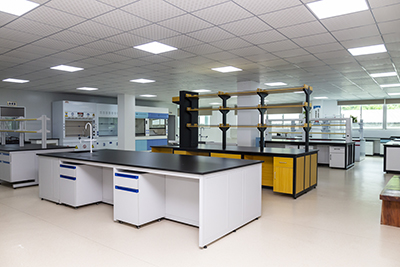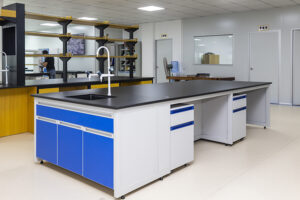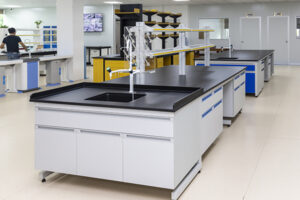In recent years, accidents in chemical laboratories have occurred frequently. The following are the accidents that occurred at China University
1.2015 Dec., Tsinghua University, Laboratory Exploded, One Killed.
2.2018 Nov., Nanjing University of Traditional Chinese Medicine, Laboratory Flammable Accident
3.2021 March, Chinese Academy of Sciences, Chemical laboratory accident, one killed.
4.2021 July, Southern University of Science and Technology, Sun Yat-sen University laboratory explosion accident, several lab researchers injured.
5.2021 Oct., Nanjing University of Aeronautics and Astronautics explosion accident, one was injured by burning.
Chemical laboratories involve toxic, flammable, and explosive hazardous chemicals, which may generate toxic, harmful, flammable, and explosive gases, waste liquids, and waste residues; some operating conditions are high temperature, high pressure, and strong Corrosion; there will also be aging of equipment and facilities, all of which pose a threat to the surrounding environment and the health and safety of operators.
Therefore, we, Fuhua , as a lab furniture manufacturer suggest all the chemical laboratory a few useful ways to help improve your laboratory in safety management. So that the accident won’t occur again.
Before we talk about the accident, we will learn more about why the accident will happen.
Unsafe Operation by Lab Researcher
Laboratory researchers have weak safety awareness and lack safety knowledge and skills. From the analysis of laboratory accidents in recent years, the experimenters do not pay attention to safety, think that the experimental dose is small and do not pay attention to the related risks, and ignore the danger of chemicals. For example, in the Beijing Jiaotong University laboratory explosion accident in December 2018, the teacher in charge of the experimental project turned a blind eye to the lively chemical properties of magnesium powder and illegally stored it in the laboratory. Some experimenters lack certain theoretical knowledge and lack of experimental operation skills, especially the low frequency of laboratory instructors in colleges and universities participating in experimental activities. The main manifestations are: first, improper use of chemicals or improper operation of instruments and equipment; second, experimenters do not wear protective equipment correctly; third, once an accident occurs, the emergency response is not clear, resulting in the expansion of the consequences of the accident.
Chemical Not Store In a Proper Way
1. The management of chemicals and gas cylinders is not standardized.
There are many kinds of laboratory chemicals, including common reagents and dangerous chemicals. Due to the large number of laboratory staff, the consumption of chemicals is large, the reagents are used at will, the access is chaotic, and there are loopholes in the management of reagents; some chemical safety labels fall off; some chemicals have been stored for a long time beyond the expiration date.
In addition, some laboratories have limited space, especially the “double first-class” university laboratories occupy a tight space, and even the phenomenon of “student workstations on the left and high-pressure gas cylinders on the right” appears. The storage place of gas cylinders is not fixed, there is no special storage place for gas cylinders, some of them are placed directly next to the equipment without even the slightest fixing means, and the gas cylinders are not inspected, tested and maintained for a long time. These factors are create a major safety hazard in the experimenters.
2. Improper management of experimental equipment and insufficient equipment integrity.
There are many kinds of experimental equipment, and maintenance is difficult.
1)Safety protection measures are not in place. The safety protection factor of some experimental equipment is relatively low, especially the pressure-bearing equipment, which is lacking in daily maintenance and pressure relief measures, and accidents are likely to occur once misoperation. For example, in 2021, the high temperature and high pressure explosion of the reactor involved in the 3.31 explosion accident of the Institute of Chemistry, Chinese Academy of Sciences resulted in the death of one student.
2) Insufficient equipment integrity. Laboratory equipment is generally imported from abroad. Once the equipment is defective, the maintenance cost is high, and the domestic maintenance personnel lack skills, which will affect the service life of the equipment; even some experimental personnel do not operate the experimental equipment, relying on their own knowledge to operate the instrument to speed up the equipment. Aging, lack of equipment life cycle management, and insufficient equipment integrity. Therefore, it is particularly important to strengthen the management of laboratory equipment and do a good job of daily maintenance for the safe conduct of experimental activities.
From a China professional lab furniture manufacturer viewpoint, we strongly suggest different chemicals should be stored in a different safety cabinet. Our flammable safe cabinet for chemicals, gas cylinder storage cabinet, and reagent storage cabinet can help you manage your chemical storage in a safe way.
Defects in management
The laboratory safety management system and mechanism are not perfect. It is manifested in the serious shortage of the number of full-time management personnel of laboratory safety in colleges and universities, lack of professional ability, and lack of knowledge about how to manage safety; laboratory safety management institutions do not play a prominent role, and chemical laboratories focus on scientific research and light safety problems. ,
Most scientific researchers generally pay attention to scientific research output, ignore safety management, and daily laboratory safety inspections remain on paper and have not been effectively implemented into actions; the safety responsibility system is imperfect, and the responsibilities are unclear and specific, especially the responsibilities of each department.
There are certain overlaps and safety management loopholes; chemical and chemical laboratory safety operating procedures are not specific and operability is not strong, some chemical laboratory personnel do not understand equipment operation, safety training is not in place, risk identification is not in place, and control measures are not in place. If it is not implemented, the risk points in chemical and chemical laboratories are ignored.
You have learned why these accident happen. Then, the following is our suggestion on how you can improve your safety management in your laboratory. The following is the three improvement measures.
I
The 5 UNDERSTANDINGS are the theoretical basis for improving laboratory safety
Five understandings, that is, understand the experimental principles and process reactions, understand the dangerous characteristics of dangerous chemicals, understand the principles of experimental equipment, understand the relevant policies and regulations of the laboratory, and understand the safety management system of the laboratory.
To understand the experimental principle and process reaction is to understand the principle and reaction process of the reaction equation. The laboratory is a place where experimental personnel conduct scientific research, and more scientific research activities are based on science-based exploration of unknown areas. It is precisely because of the unpredictability that it is necessary to be familiar with the reaction process and operation links, accurately grasp the control indicators of the reactants, such as pressure, temperature, flow, concentration and other experimental parameters, and know that it is an endothermic reaction and an exothermic reaction.
Understanding experimental principles and process reactions is the basis for correct analysis of experimental results and risk control. To understand the hazard characteristics of hazardous chemicals means that the laboratory personnel must know the hazard identification, physical and chemical properties, first aid measures, fire protection measures, health hazards, operation and storage requirements of hazardous chemicals in the laboratory. There are explosives, oxidizing gases, gases under pressure (gas cylinders), flammable liquids, flammable solids, spontaneous combustion liquids, substances that emit flammable gases in contact with water, metal corrosives, toxic and harmful substances, etc. Reagents and chemicals should have safety technical instructions, and laboratory personnel should be aware of their hazards, storage requirements and emergency measures. In case of fire, heat and humidity, it can cause combustion, explosion or chemical reaction.
Chemicals that produce toxic gases should be careful to prevent fire, heat, moisture and water. Explosives should be handled with care to avoid friction, vibration and impact Explosion occurs; the gas cylinders in the laboratory building should be managed in the gas cylinder room, and the combustible gas, combustion-supporting gas and non-combustible gas should be stored separately in a inflammable storage cabinet. At the same time, there are safety relief facilities on the gas cylinder, and there must be safety accessories such as pressure gauges and emergency cut-off devices. And it should be checked regularly, and overpacking is strictly prohibited; corrosive items should be tightly packed to avoid leakage, and must not coexist with liquefied gas. The specific content of waste disposal must comply with relevant laws and regulations.
Understanding the dangerous characteristics of substances involved in the experiment process plays an important guiding role in precise operation and emergency response, and helps prevent laboratory safety accidents.
To understand the principle of experimental equipment is to master the skills of starting and stopping the equipment. There are many equipment in the laboratory, including pressure equipment, reactor equipment, separation equipment, heating, etc., pressure equipment with high pressure, separation equipment rotating at high speed, etc. A misoperation by the experimenter will cause unimaginable consequences. Experimenters must be familiar with the safety operation procedures of the equipment and not operate in violation of regulations, so as to effectively prevent the abnormality of the equipment from threatening the experimenters. To understand the relevant policies and regulations of the laboratory is to master the relevant regulations related to laboratory management.
To understand the safety management system of the laboratory is to formulate a management system that meets the requirements of standard standards and is compatible with the safety management of the laboratory and implements it effectively. The safety management system is the basic carrier to standardize the workflow and requirements of experimenters, so the system must be operable and enforceable. At the school level, the laboratory safety management system should be formulated around three aspects: management system, inspection system, and responsibility system; Construction, inspection, laboratory equipment operation procedures, etc., such as hazardous chemicals management, gas cylinder management, waste disposal, facility equipment management system, etc.
II
5 capability is the ability requirement to improve laboratory safety
The five sessions are the skills that laboratory personnel need to master, and are the ability requirements. The 5 CAN will be experimental operation, troubleshooting, equipment inspection, risk analysis, and emergency response. If you know how to operate the experiment, you can accurately control the entire reaction process of the experiment. In particular, it is necessary to know the feeding sequence of the reactants, the amount of materials, the accurate grasp of the time node and reaction time, and the precise experimental parameter conditions (high temperature, high pressure, etc.). Before the experiment, the experimental steps should be written accurately, and the content should be clear and clear. Troubleshooting, that is, the handling of emergencies in the experimental process and equipment failures.
Experimenters are aware of the consequences of water, electricity, gas, etc. during the experiment, and deal with them in a timely manner. There should also be handling procedures for sudden interruption of the experimental process, and safe handling methods for sudden equipment failures (abnormal sound, temperature surge, etc.). In addition, the experimenter has the ability to reasonably analyze the product, explain the failure to achieve the expected experimental results, and find the reason.
The equipment will be checked, that is, the experimental equipment will be checked. Laboratory equipment is complicated, and each equipment has corresponding operating procedures. In the daily management, the inspection of the experimental equipment should be strengthened, and the inspection and maintenance should be carried out regularly according to the inspection points and requirements, and the specific content, specific location and inspection indicators of the inspection should be recorded. Risk analysis, that is, taking appropriate risk assessment methods to analyze the hazards in the laboratory and the risks in the experimental process.
During the experiment, there may be dangers such as mechanical, electrical, high and low temperature, fire and explosion, noise, vibration, poisoning, etc. It is necessary to systematically identify hazards from personnel, equipment, objects, and the environment, and use reasonable risk analysis methods. Risk assessment to ensure the safety of the experimental process. Experimenters deal with dangerous events that occur during the experiment according to the relevant plans, and will be able to use emergency escape methods, first aid methods for the injured, and emergency equipment such as fire fighting and gas defense.
The laboratory should be equipped with safety protection facilities such as fire extinguishers, fire hydrants, eye washers, emergency sprinklers, and small medicine boxes, which should be kept in good condition. The general laboratory has a risk of fire or explosion, and automatic alarm equipment should also be installed, and fire-extinguishing devices and appropriate types of fire extinguishers should be installed.
When any automatic, artificial fire or gas monitoring, protection or alarm device is activated, the mechanical ventilation system shall extract air so that no circulation is formed. The ventilation capacity of the laboratory should be adapted to the current laboratory operation, and emergency training and drills should be strengthened at ordinary times to ensure that abnormal situations can be dealt with in a timely manner.
III
5 CAN are behavioral requirements to improve laboratory safety.
It is can abide by the process reaction discipline, the safety discipline, the labor discipline, can stop others from illegal operations, can resist illegal guidance.
Can abide by the process reaction discipline, that is, require the experimenter to operate in strict accordance with the experimental steps, and do not arbitrarily change the experimental parameter data and reaction conditions.
At the same time, some basic rules of conduct must be followed to ensure the safe conduct of experiments. To be able to abide by safety discipline, that is, to abide by the basic safety management system, such as hazardous chemicals management, gas cylinder management, waste disposal, facility and equipment management system, etc., and to do a good job in self-protection during the experiment, and wear personal protective equipment correctly.
Can abide by labor discipline, that is, do not do things unrelated to the experiment during the experiment, do not play with mobile phones, do not fall asleep, etc. Can stop other people’s illegal operation, that is, can stop the experimenter’s illegal behavior. For example, adding reagents and medicines by hand, eating and drinking in the laboratory, etc.
Can resist illegal instructions, and firmly refuse to violate laboratory safety management regulations and operational requirements. In order to pursue experimental efficiency, some chemical and chemical laboratories operate illegally without controlling safety risks. Experimenters should resolutely resist.
Finally, on the basis of “understanding and knowing”, set up a professional chemical and chemical laboratory safety management department, so that the role of the safety management department can be brought into full play, increase the education and training of chemical and chemical laboratory personnel, and improve the The safety management level of chemical and chemical experiments ensures the safe operation of chemical and chemical laboratories.




